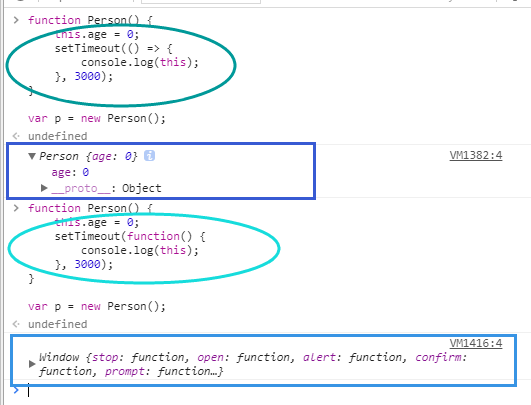javascript中的this指向
一、全局环境下
在全局环境下,this 始终指向全局对象(window), 无论是否严格模式;
console.log(this.document === document); // true // 在浏览器中,全局对象为 window 对象: console.log(this === window); // true this.a = 37; console.log(window.a); // 37
二、函数上下文调用
2.1函数直接调用
普通函数内部的this分两种情况,严格模式和非严格模式。
非严格模式下,this 默认指向全局对象window
function f1(){ return this; } f1() === window; // true
而严格模式下, this为undefined
function f2(){ "use strict"; // 这里是严格模式 return this; } f2() === undefined; // true
2.2对象中的this
对象内部方法的this指向调用这些方法的对象:
- 函数的定义位置不影响其this指向,this指向只和调用函数的对象有关。
- 多层嵌套的对象,内部方法的this指向离被调用函数最近的对象(window也是对象,其内部对象调用方法的this指向内部对象, 而非window)。
//1 var o = { prop: 37, f: function() { return this.prop; } }; console.log(o.f()); //37 var a = o.f; console.log(a()): //undefined(a()相当于window.a(),所以a的this指向window,而window.prop为undefined,所以结果为undfined) var o = {prop: 37}; function independent() { return this.prop; } o.f = independent; console.log(o.f()); // logs 37 //2 o.b = { g: independent, prop: 42 }; console.log(o.b.g()); // logs 42
2.3原型链中this
原型链中的方法的this仍然指向调用它的对象,与以上讨论一致;看个例子:
var o = { f : function(){ return this.a + this.b; } }; var p = Object.create(o); p.a = 1; p.b = 4; console.log(p.f()); // 5
2.4构造函数中this
构造函数中的this与被创建的新对象绑定。
function C(){ this.a = 37; } var o = new C(); console.log(o.a); // logs 37 function C2(){ this.a = 37; return {a:38}; } var b = new C2(); console.log(b.a); // logs 38
注意:
如果构造函数返回值为常规意义上的数值类型(Number、String、Boolean)时,new函数将会返回一个该函数的实例对象(类C),
而如果构造函数返回一个引用类型(Object、Array、Function)时,则new函数与直接调用函数产生的结果相同,都返回这个引用(类C2)。
2.5call & apply
当函数通过Function对象的原型中继承的方法 call() 和 apply() 方法调用时, 其函数内部的this值可绑定到 call() & apply() 方法指定的第一个对象上(函数将被永远绑定在其第一个参数对象上, 而无论其在什么情况下被调用), 如果第一个参数不是对象,JavaScript内部会尝试将其转换成对象然后指向它。
function add(c, d){ return this.a + this.b + c + d; } var o = {a:1, b:3}; add.call(o, 5, 7); // 1 + 3 + 5 + 7 = 16 add.apply(o, [10, 20]); // 1 + 3 + 10 + 20 = 34 function tt() { console.log(this); } // 返回对象见下图(图1) tt.call(5); // Number {[[PrimitiveValue]]: 5} tt.call('asd'); // String {0: "a", 1: "s", 2: "d", length: 3, [[PrimitiveValue]]: "asd"}

第一个参数不是对象,JavaScript内部会尝试将其转换成对象然后指向它。
2.6bind 方法
bind方法在ES5引入, 在Function的原型链上, Function.prototype.bind。通过bind方法绑定后, 函数将被永远绑定在其第一个参数对象上, 而无论其在什么情况下被调用。
function f(){ return this.a; } var g = f.bind({a:"azerty"}); console.log(g()); // azerty var o = {a:37, f:f, g:g}; console.log(o.f(), o.g()); // 37, azerty
2.7DOM 事件处理函数中的 this & 内联事件中的 this
DOM事件处理函数
- 当函数被当做监听事件处理函数时, 其 this 指向触发该事件的元素 (针对于addEventListener事件)
// 被调用时,将关联的元素变成蓝色 function bluify(e){ //在控制台打印出所点击元素 console.log(this); //阻止时间冒泡 e.stopPropagation(); //阻止元素的默认事件 e.preventDefault(); this.style.backgroundColor = '#A5D9F3'; } // 获取文档中的所有元素的列表 var elements = document.getElementsByTagName('*'); // 将bluify作为元素的点击监听函数,当元素被点击时,就会变成蓝色 for(var i=0 ; i<elements.length ; i++){ elements[i].addEventListener('click', bluify, false); }
内联事件
内联事件中的this指向分两种情况:
- 当代码被内联处理函数调用时,它的this指向监听器所在的DOM元素
- 当代码被包括在函数内部执行时,其this指向等同于 函数直接调用的情况,即在非严格模式指向全局对象window, 在严格模式指向undefined



2.8setTimeout & setInterval
延时函数内部的回调函数的this指向全局对象window:超时调用的代码都是在全局作用域中执行的,因此函数中this的值在非严格模式下指向window对象,在严格模式下是undefined(当然我们可以通过bind方法改变其内部函数的this指向)
//默认情况下代码 function Person() { this.age = 0; setTimeout(function() { console.log(this); }, 3000); } var p = new Person();//3秒后返回 window 对象 ============================================== //通过bind绑定 function Person() { this.age = 0; setTimeout((function() { console.log(this); }).bind(this), 3000); } var p = new Person();//3秒后返回构造函数新生成的对象 Person{...}
三、箭头函数中的 this
由于箭头函数不绑定this, 它会捕获其所在(即定义的位置)上下文的this值作为自己的this值,
- 所以 call() / apply() / bind() 方法对于箭头函数来说只是传入参数,对它的 this 毫无影响。
- 考虑到 this 是词法层面上的,严格模式中与 this 相关的规则都将被忽略。(可以忽略是否在严格模式下的影响)
3.1因为箭头函数可以捕获其所在上下文的this值 所以
function Person() { this.age = 0; setInterval(() => { // 回调里面的 `this` 变量就指向了期望的那个对象了 this.age++; }, 3000); } var p = new Person();
以上代码可以得到我们所以希望的值,下图可以看到,在setTimeout中的this指向了构造函数新生成的对象,而普通函数指向了全局window对象

var adder = { base : 1, add : function(a) { var f = v => v + this.base; return f(a); }, addThruCall: function inFun(a) { var f = v => v + this.base; var b = { base : 2 }; return f.call(b, a); } }; console.log(adder.add(1)); // 输出 2 console.log(adder.addThruCall(1)); // 仍然输出 2(而不是3,其内部的this并没有因为call() 而改变,其this值仍然为函数inFun的this值,指向对象adder
3.2箭头函数的this在严格模式与非严格模式下指向相同:
var f = () => {'use strict'; return this}; var p = () => { return this}; console.log(1,f() === window); console.log(2,f() === p()); //1 true //2 true
3.3作为方法的箭头函数this指向全局window对象,而普通函数的this则指向调用它的对象:
var obj = { i: 10, b: () => console.log(this.i, this), c: function() { console.log( this.i, this) } } obj.b(); // undefined window{...} obj.c(); // 10 Object {...}
转自:https://www.cnblogs.com/dongcanliang/p/7054176.html
参照:https://www.cnblogs.com/jeodeng/p/10658590.html
参照:https://www.cnblogs.com/yuqingfamily/p/5816560.html



